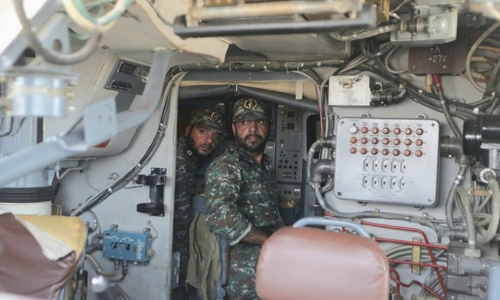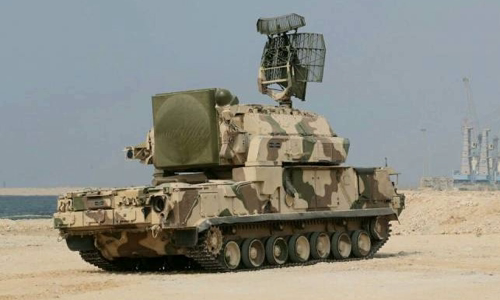The inexperienced, tense air defense and lack of communication with their superiors may have made many mistakes when shooting down Ukrainian aircraft.
"We are in a state of readiness to start a full-scale war with the United States. The air defense system mistook the civilian plane as a cruise missile," said General Amirali Hajizadeh, commander of the space space arm of the United States. Iranian Revolutionary Guards (IRGC), on television, explained on Iran the wrongful shooting of a flight number PS752 by Ukraine International Airlines (UIA), which killed 176 people.

Crew operating the Iran Tor-M1 complex in the 2019 exercise Photo: Mehr News
Details of the incident remain unclear, as an investigation is still underway. However, experts concur that the preventive measures to prevent such disasters all fail, showing that a series of errors have occurred at all levels of management and operational operations of the Iranian military.
"There are a number of potential problems in this incident. It shows that the operating system and technology have failed. There should be a method to prevent the wrong shootings," said Steven Zaloga, a rocket analyst with Teal Group, commented.
General Hajizadeh said the incident happened when the Iranian armed forces were being put on high combat readiness, preparing to respond to a potential retaliatory strike from the US and "the risk of a war." Unprecedented painting "since the 1979 Islamic Revolution. The Iranian army has only reported that Ukrainian aircraft were shot down by a short-range air defense complex, while US intelligence identified the weapon used as a name. Russian-made Tor-M1 fire.
Tor is a short-range self-propelled air defense system developed by the Soviet Union in 1975 and put into service in 1986, designed specifically to intercept guided weapons like AGM-86 ALCM cruise missiles in all things. weather conditions and warfare, even when jammed by enemies. The Tor-M1 version of Iran has been significantly upgraded to increase accuracy.
The digital fire control system makes Tor's automation much higher than previous Soviet air defense systems. It has fully automatic enemy identification (IFF) and threat classification.
A highly effective short-range air defense system, the Tor-M1 is often used in war zones where civilian aircraft are often absent. Its IFF system only recognizes friendly or hostile military aircraft, but it is difficult to distinguish between passenger aircraft, cruise missiles or fighter jets.
Therefore, the countries that operate this air defense complex often connect Tor to a larger air defense system capable of detecting and tracking civil aircraft, according to Zaloga. Within that network, soldiers operating the Tor complex would not fire without receiving orders from higher command.
With this multi-layered air defense network, Ukraine's Boeing 737-800 is easily identifiable, as it constantly signals its position to air traffic control radars and surveillance systems. Latest aviation based on GPS signal.
But Iran seems to have made the first mistake of arranging the Tor-M1 system at Mehrabad air base separately. An Iranian official acknowledged that the crew had to act independently because the communication was interrupted, but did not specify the cause of the communication between the soldiers and the superior.
The system is located on the outskirts of Tehran, located right on the route of civil aircraft departing from Imam Khomeini International Airport. The British Telegraph believes that the most plausible explanation is that the Tor-M1 missile crew has actively shut down vehicle communication systems, preventing US electronic warfare devices from detecting and attacking them. .

The Tor-M1 fighting vehicle was announced by Iran in 2012 Photo: IRNA
This action makes the trackers on the Tor-M1 vehicle significantly limited overall awareness of the battlefield, as well as not knowing which civil aircraft have just taken off at the nearby airport. In such circumstances, inexperienced or untrained soldiers are more likely to make catastrophic mistakes, especially when they are in extreme stress due to fear of the risk of an American attack.
"They only have 10 seconds to decide whether or not to fire the bullet," said General Hajizadeh. In those 10 seconds, two bullets were fired continuously, when the bright spot of the Boeing 737-800 appeared on the radar display.
The Iranian military said the soldiers mistook the aircraft as a "hostile target" because of its shape, altitude and aircraft suddenly turning toward a military base. However, the flight data on the FlightRadar24 tracking page shows that the Boeing 737-800 uses the familiar flight route when leaving Imam Khomenei International Airport, two other aircraft previously had similar routes.
"Even if the passenger plane's flight is unclear, the anti-aircraft batteries will have to identify its flight trajectory and its radar signal is different from US cruise missiles or military aircraft," Justin Bronk, an expert at the Royal British Military Institute, commented.
Cruise missiles often fly dozens of meters from the ground at a speed of hundreds of kilometers per hour, while PS752 flight continuously increased altitude to 2,400 m and only reached a speed of no more than 500 km / h before hitting the rocket. .
The incident also showed limitations with Iran's air defenses. The country has had some successes such as shooting down US $ 200 million RQ-4A BAMS-D drones (UAVs), but Iran's air defense network is still considered backward and inefficient.
"The problem may lie in the training process, when Iranian soldiers think they are better than they really are," Zaloga said.
Many aviation experts are also puzzled when Iran did not close its airspace after the raid in response to the US and still allowed civilian aircraft to take off normally in the capital Tehran. "The Iranian sky was very hot then. Everyone was nervous due to the high alert state, mixed with anxiety and confusion. And yet they still opened the airspace, I thought it was irresponsible irresponsibility." believe, "commented General James Marks, a former US Army intelligence officer.
"Iranian officials may allow civilian flight to take place because they do not want to admit behind the raid on US bases in Iraq. That puts a series of passenger planes in jeopardy," said Simon Petersen, chief executive officer of the US Army. Director of missile program of Swedish defense corporation Terma A / S, stated the point.



 EndiaWilson-Evans
EndiaWilson-Evans







